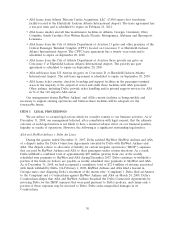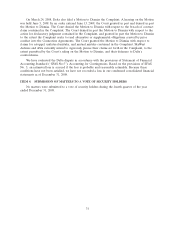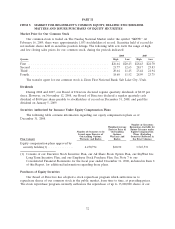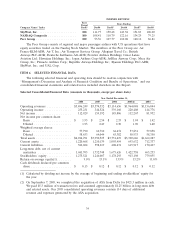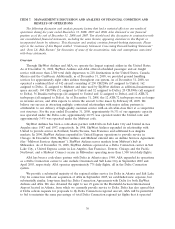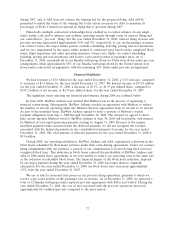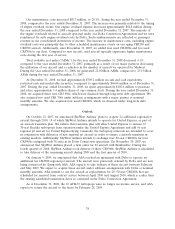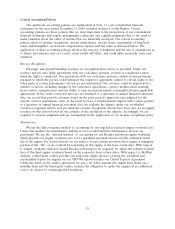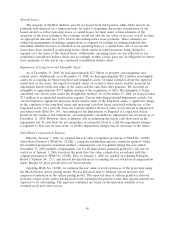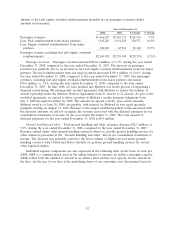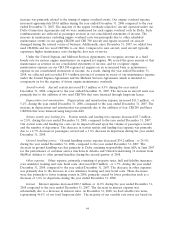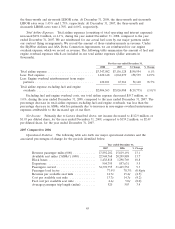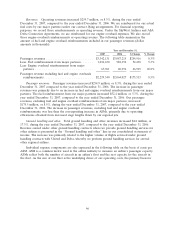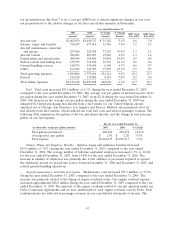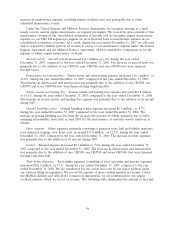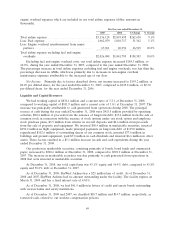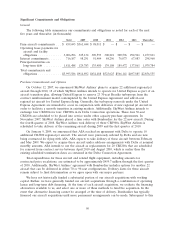SkyWest Airlines 2008 Annual Report Download - page 44
Download and view the complete annual report
Please find page 44 of the 2008 SkyWest Airlines annual report below. You can navigate through the pages in the report by either clicking on the pages listed below, or by using the keyword search tool below to find specific information within the annual report.Aircraft Leases
The majority of SkyWest Airlines’ aircraft are leased from third parties, while ASA’s aircraft are
primarily debt-financed on a long-term basis. In order to determine the proper classification of our
leased aircraft as either operating leases or capital leases, we must make certain estimates at the
inception of the lease relating to the economic useful life and the fair value of an asset as well as select
an appropriate discount rate to be used in discounting future lease payments. These estimates are
utilized by management in making computations as required by existing accounting standards that
determine whether the lease is classified as an operating lease or a capital lease. All of our aircraft
leases have been classified as operating leases, which results in rental payments being charged to
expense over the terms of the related leases. Additionally, operating leases are not reflected in our
condensed consolidated balance sheet and accordingly, neither a lease asset nor an obligation for future
lease payments is reflected in our condensed consolidated balance sheet.
Impairment of Long-Lived and Intangible Assets
As of December 31, 2008, we had approximately $2.7 billion of property and equipment and
related assets. Additionally, as of December 31, 2008, we had approximately $26.2 million in intangible
assets. In accounting for these long-lived and intangible assets, we make estimates about the expected
useful lives of the assets, the expected residual values of certain of these assets, and the potential for
impairment based on the fair value of the assets and the cash flows they generate. We recorded an
intangible of approximately $33.7 million relating to the acquisition of ASA. The intangible is being
amortized over fifteen years under the straight-line method. As of December 31, 2008, we had recorded
$7.5 million in accumulated amortization expense. Factors indicating potential impairment include, but
are not limited to, significant decreases in the market value of the long-lived assets, a significant change
in the condition of the long-lived assets and operating cash flow losses associated with the use of the
long-lived assets. On a periodic basis, we evaluate whether the book value of our aircraft is impaired in
accordance with SFAS No. 144, ‘‘Accounting for the Impairment or Disposal of Long-Lived Assets.’’
Based on the results of the evaluations, our management concluded no impairment was necessary as of
December 31, 2008. However, there is inherent risk in estimating the future cash flows used in the
impairment test. If cash flows do not materialize as estimated, there is a risk the impairment charges
recognized to date may be inaccurate, or further impairment charges may be necessary in the future.
Stock-Based Compensation Expense
Effective January 1, 2006, we adopted the fair value recognition provisions of SFAS No. 123(R),
Share-Based Payment (‘‘SFAS No. 123(R)’’), using the modified-prospective transition method. Under
the modified-prospective transition method, compensation cost recognized during the year ended
December 31, 2006 includes compensation cost for all share-based payments granted to, but not yet
vested as of January 1, 2006, based on the grant date fair value estimated in accordance with the
original provisions of SFAS No. 123(R). Prior to January 1, 2006, we applied Accounting Principles
Board (‘‘Opinion No. 25’’), and related interpretations in accounting for our stock-based compensation
plans. Results for prior periods have not been restated.
Applying SFAS No. 123(R), we estimate the fair value of stock options as of the grant date using
the Black-Scholes option pricing model. We use historical data to estimate option exercises and
employee termination in the option pricing model. The expected term of options granted is derived
from the output of the option pricing model and represents the period of time that options granted are
expected to be outstanding. The expected volatilities are based on the historical volatility of our
common stock and other factors.
40


